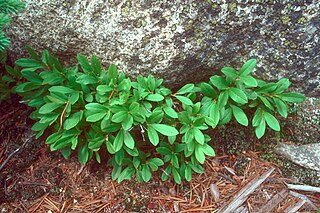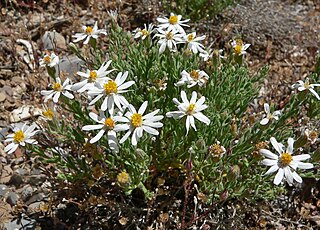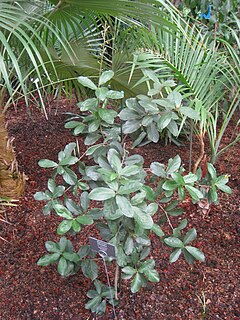
Atriplex confertifolia, the shadscale, is a species of evergreen shrub in the family Amaranthaceae, which is native to the western United States and northern Mexico.

Chaenactis is a genus of plants in the daisy family which are known generally as pincushions or dustymaidens.

Vaccinium cespitosum, the dwarf bilberry, is a species of flowering shrub in the genus Vaccinium, which includes blueberries, huckleberries, and cranberries.

Chaetopappa is a genus of plants in the daisy family which are known generally as leastdaisies.
Adenopappus is a genus of plants in the family Asteraceae described as a genus in 1840.
Geissolepis is a genus of flowering plants in the daisy family.
Chromolepis is a genus of flowering plants in the sunflower family.

Quercus oleoides, with Spanish common names encina or encino, is a Mesoamerican species of oak in the white oak group. It grows in dry forests and pastureland of eastern and southern Mexico and much of Central America, from Guanacaste Province in Costa Rica north as far as the State of Tamaulipas in northeastern Mexico.
Berberis chochoco is an evergreen shrub or small tree up to 9 m (30 ft) tall, in the genus Berberis, family Berberidaceae. It is native to mountainous regions of northeastern Mexico, in the states of Nuevo León, Veracruz, and San Luis Potosí.

Neolloydia conoidea, common name Texas cone cactus or Chihuahuan beehive, is a species of cactus native to western Texas and to the Mexican states of Coahuila, Durango, Nuevo León, San Luis Potosí, Tamaulipas, and Zacatecas. It is a part of the Chihuahuan Desert desert scrub and the Tamaulipan thorn scrub.

Ternstroemia lineata is a plant species native to high elevations in central Mexico. Many publications call this T. pringlei, but more recent publications confirm that the correct name is T. lineata.
Berberis hartwegii is a shrub in the Berberidaceae described as a species in 1840. It is endemic to Mexico, found in the States of Hidalgo, San Luis Potosí, and Tamaulipas.
Berberis pallida is a shrub in the Berberidaceae described as a species in 1840. It is endemic to Mexico, known from the States of Guanajuato, Hidalgo, Oaxaca, Veracruz, Puebla, Querétaro, and Tamaulipas.
Berberis pallida is a shrub in the Berberidaceae described as a species in 1901. It is endemic to the State of Hidalgo in eastern Mexico.
Mahonia zimapana is a shrub in the Berberidaceae described as a species in 1901. It is an uncommon species native to the States of Mexico and Hidalgo in Mexico.
Mahonia incerta is a shrub described as a species in 1901. It is endemic to eastern Mexico, known from the States of Hidalgo and Veracruz.
Mahonia eutriphylla is a species of shrub in the Berberidaceae described as a species in 1901. It is endemic to northern and central Mexico, from Coahuila to Mexico State.
Hedosyne is a genus of plants in the sunflower family.
Baccharis pteronioides is a North American shrub in the aster family known by the common name Yerba de pasmo. It is widespread in Mexico and also found in the southwestern United States.
Baccharis thesioides is a North American species of shrubs in the aster family known by the common name Arizona baccharis. It is widespread in Mexico from Chihuahua to Oaxaca, and also found in the southwestern United States.






